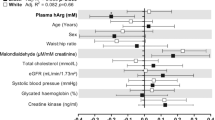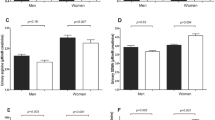Abstract
Inadequate substrate availability and increased nitric oxide synthase inhibitor levels attenuate nitric oxide (NO) synthesis, whereas increased vascular oxidative stress may lead to inactivation of NO. We compared markers of NO synthesis capacity and oxidative stress in a bi-ethnic male population. Inter-relationships of ambulatory blood pressure and urinary albumin-to-creatinine ratio with NO synthesis capacity and oxidative stress markers were investigated. NO synthesis capacity markers (L-arginine, asymmetric dimethylarginine (ADMA), and symmetric dimethylarginine (SDMA)) and oxidative stress markers (serum peroxides, total glutathione, glutathione peroxidase (GPx), glutathione reductase (GR), superoxide dismutase (SOD), and catalase) were measured. Black men displayed higher blood pressure and albumin-to-creatinine ratio (all p < 0.001), while NO synthesis capacity was more favorable (higher L-arginine and lower ADMA (p ≤ 0.003)). Antioxidant enzyme activities were similar except for the redox status markers (GR activity and GR/GPx ratio), which were upregulated in black men (p < 0.001). In black men, ADMA was inversely related to GPx activity (R 2 = 0.15; β = −0.20; p = 0.050) and GPx/SOD ratio (R 2 = 0.24; β = −0.37; p < 0.001), but none of these markers related to blood pressure or albumin-to-creatinine ratio. In white men, albumin-to-creatinine ratio was positively associated with ADMA (R 2 = 0.18; β = 0.39; p < 0.001) while ADMA was inversely related to GR activity (R 2 = 0.26; β = −0.29; p = 0.002) and GR/GPx ratio (R 2 = 0.25; β = −0.28; p = 0.003). Black men with elevated blood pressure and albumin-to-creatinine ratio displayed a favorable NO synthesis capacity. This may be counteracted by increased inactivation of NO, although it was not linked to vascular or renal phenotypes. In white men, reduced NO synthesis capacity may lower NO bio-availability, thereby influencing the albumin-to-creatinine ratio.


Similar content being viewed by others
References
Alacam H et al. (2013) Does ADMA affect the oxidant/antioxidant balance in rats? Turk J Med Sci 43:405–410
Böger RH (2005) Asymmetric dimethylarginine (ADMA) and cardiovascular disease: insights from prospective clinical trials. Vasc Med 10:S19–S25. doi:10.1191/1358863x05vm602oa
Böger RH (2007) The pharmacodynamics of L-arginine. J Nutr 137:1650S–1655S
Cooke JP (2004) Asymmetrical dimethylarginine the über marker? Circulation 109:1813–1818. doi:10.1161/01.CIR.0000126823.07732.D5
De Haan J, Cristiano F, Iannello RC, Kola I (1995) Cu/Zn-superoxide dismutase and glutathione peroxidase during aging. Biochem Mol Biol Int 35:1281–1297
Dharmashankar K, ME W (2010) Vascular endothelial function and hypertension: insights and directions. Curr Hypertens Rep 12:448–455. doi:10.1007/s11906-010-0150-2
Dittmar M, Knuth M, Beineke M, Epe B (2008) Role of oxidative DNA damage and antioxidative enzymatic defence systems in human aging. Open Anthropol J 1:38–45. doi:10.2174/1874912700801010038
Endemann DH, EL S (2004) Endothelial dysfunction. J Am Soc Nephrol 15:1983–1992. doi:10.1097/01.ASN.0000132474.50966
Fan N-C, Tsai C-M, Hsu C-N, Huang L-T, Tain Y-L (2013) N-acetylcysteine prevents hypertension via regulation of the ADMA-DDAH pathway in young spontaneously hypertensive rats Biomed Res Int 2013:1–9 doi:org/10.1155/2013/696317
Glyn M et al. (2012) Ethnicity-specific differences in L-arginine status in South African men. J Hum Hypertens 26:737–743. doi:10.1038/jhh.2011.103
Hayashi I, Morishita Y, Imai K, Nakamura M, Nakachi K, Hayashi T (2007) High-throughput spectrophotometric assay of reactive oxygen species in serum. Mutat Res Genet Toxicol Environ Mutagen 631:55–61. doi:10.1016/j.mrgentox.2007.04.006
Ito A, Tsao PS, Adimoolam S, Kimoto M, Ogawa T, JP C (1999) Novel mechanism for endothelial dysfunction dysregulation of dimethylarginine dimethylaminohydrolase. Circulation 99:3092–3095. doi:10.1161/01.CIR.99.24.3092
Kearney PM, Whelton M, Reynolds K, Muntner P, PK W, J H (2005) Global burden of hypertension: analysis of worldwide data. Lancet 365:217–223. doi:10.1016/S0140-6736(05)17741-1
Kohara K, Nishida W, Maguchi M, Hiwada K (1995) Autonomic nervous function in non-dipper essential hypertensive subjects evaluation by power spectral analysis of heart rate variability. Hypertension 26:808–814. doi:10.1161/01.HYP.26.5.808
Kruger R et al. (2012) Associations between reactive oxygen species, blood pressure and arterial stiffness in black south africans: the SABPA study. J Hum Hypertens 26:91–97. doi:10.1038/jhh.2010.134
Lammertyn L, Mels CM, Pieters M, Schutte AE, Schutte R (2015) Ethnic-specific relationships between haemostatic and oxidative stress markers in black and white South Africans: The SABPA study. Clin Exp Hypertens 28:1–7. doi:10.3109/10641963.2015.1013123
Leiper J, Murray-Rust J, McDonald N, Vallance P (2002) S-nitrosylation of dimethylarginine dimethylaminohydrolase regulates enzyme activity: further interactions between nitric oxide synthase and dimethylarginine dimethylaminohydrolase. Proc Natl Acad Sci 99:13527–13532. doi:10.1073/pnas.212269799
Lloyd-Sherlock P, Beard J, Minicuci N, Ebrahim S, Chatterji S (2014) Hypertension among older adults in low-and middle-income countries: prevalence, awareness and control. Int J Epidemiol 43:116–128. doi:10.1093/ije/dyt215
Malan L, Hamer M, Frasure-Smith N, Steyn HS, Malan NT (2014) COHORT PROFILE: Sympathetic activity and Ambulatory Blood Pressure in Africans (SABPA) Prospective Cohort Study Int J Epidemiol doi:10.1093/ije/dyu199
Mancia G et al. (2013) 2013 practice guidelines for the management of arterial hypertension of the European Society of Hypertension (ESH) and the European Society of Cardiology (ESC): ESH/ESC Task Force for the management of arterial hypertension. J Hypertens 31:1925–1938. doi:10.1097/HJH.0b013e328364ca4c
Marfell-Jones MJ, Stewart A, de Ridder J (2012) International standards for anthropometric assessment. International Society for the Advancement of Kinanthropometry. Wellington, New Zealand
Melikian N et al. (2007) Asymmetric dimethylarginine and reduced nitric oxide bioavailability in young Black African men. Hypertension 49:873–877. doi:10.1161/01.HYP.0000258405.25330.80
Mels C et al. (2013) The link between vascular deterioration and branched chain amino acids in a population with high glycated haemoglobin: the SABPA study. Amino Acids 45:1405–1413. doi:10.1007/s00726-013-1611-0
Mels CM et al. (2014) 8-Oxo-7, 8-dihydro-2′-deoxyguanosine, reactive oxygen species and ambulatory blood pressure in African and Caucasian men: the SABPA study. Free Radic Res 48:1291–1299. doi:10.3109/10715762.2014.951840
Noronha-Dutra AA, Epperlein MM, Woolf N (1993) Reaction of nitric oxide with hydrogen peroxide to produce potentially cytotoxic singlet oxygen as a model for nitric oxide-mediated killing. FEBS Lett 321:59–62. doi:10.1016/0014-5793(93)80621-Z
Pedrinelli R, Dell’Omo G, Penno G, Mariani M (2001) Non-diabetic microalbuminuria, endothelial dysfunction and cardiovascular disease. Vasc Med 6:257–264. doi:10.1177/1358836X0100600410
Puchau B, Zulet MA, Urtiaga G, Navarro-Blasco Í, JA M (2009) Asymmetric dimethylarginine association with antioxidants ntake in healthy young adults: a role as an indicator of metabolic syndrome features. Metabolism 58:1483–1488. doi:10.1016/j.metabol.2009.04.037
Reimann M et al. (2013) Effects of acute and chronic stress on the L-arginine nitric oxide pathway in black and white South Africans: the sympathetic activity and ambulatory blood pressure in Africans study. Psychosom Med 75:751–758. doi:10.1097/PSY.0b013e3182a3e465
Schutte AE et al. (2010) Dimethylarginines: their vascular and metabolic roles in Africans and Caucasians. Eur J Endocrinol 162:525–533. doi:10.1530/EJE-09-0865
Schutte R et al. (2011) Arterial stiffness, ambulatory blood pressure and low-grade albuminuria in non-diabetic African and Caucasian men: the SABPA study. Hypertens Res 34:862–868. doi:10.1038/hr.2011.45
Schutte R et al. (2009) Blood glutathione and subclinical atherosclerosis in African men: the SABPA study. Am J Hypertens 22:1154–1159. doi:10.1038/ajh.2009.158
Schwedhelm E, Tan-Andresen J, Maas R, Riederer U, Schulze F, RH B (2005) Liquid chromatography–tandem mass spectrometry method for the analysis of asymmetric dimethylarginine in human plasma. Clin Chem 51:1268–1271. doi:10.1373/clinchem.2004.046037
Siegerink B et al. (2013) Asymmetric and symmetric dimethylarginine and risk of secondary cardiovascular disease events and mortality in patients with stable coronary heart disease: the KAROLA follow-up study. Clin Res Cardiol 102:193–202. doi:10.1007/s00392-012-0515-4
Śladowska-Kozłowska J et al. (2012) Oxidative stress in hypertensive children before and after 1 year of antihypertensive therapy. Pediatr Nephrol 27:1943–1951. doi:10.1007/s00467-012-2193-x
Sliwa K, Wilkinson D, Hansen C, Ntyintyane L, Tibazarwa K, Becker A, Stewart S (2008) Spectrum of heart disease and risk factors in a black urban population in South Africa (the Heart of Soweto Study): a cohort study. Lancet 371:915–922. doi:10.1016/S0140-6736(08)60417-1
Sözmen B, Kazaz C, TASKIRAN D, Aslan L, Akyol A, EY S (1998) Plasma antioxidant status and nitrate levels in patients with hypertension and coronary heart disease. Turk J Med Sci 28:525–532
Tousoulis D, A-M K, Tentolouris Nikolaos Papageorgiou C, Stefanadis C (2012) The role of nitric oxide on endothelial function. Curr Vasc Pharmacol 10:4–18. doi:10.2174/157016112798829760
Tsioufis C et al. (2010) ADMA, C-reactive protein, and albuminuria in untreated essential hypertension: a cross-sectional study. Am J Kidney Dis 55:1050–1059. doi:10.1053/j.ajkd.2009.11.024
Vásquez-Vivar J et al. (1998) Superoxide generation by endothelial nitric oxide synthase: the influence of cofactors. Proc Natl Acad Sci 95:9220–9225
Wang D, Strandgaard S, Iversen J, Wilcox CS (2009) Asymmetric dimethylarginine, oxidative stress, and vascular nitric oxide synthase in essential hypertension. Am J Physiol Regul Integr Comp Physiol 296:R195–R200. doi:10.1152/ajpregu.90506.2008
Acknowledgments
The SABPA study would not have been possible without the voluntary collaboration of the participants and the Department of Education, North-West Province, South Africa. We gratefully acknowledge the technical assistance of Mariola Kastner, Anna Steenpass, Mrs. Tina Scholtz, Dr. Szabolcs Péter, and Sr Chrissie Lessing. This study was supported by the National Research Foundation; the National Research Foundation Thuthuka (80643); the Medical Research Council, the North-West University, Potchefstroom; Roche Products (Pty) Ltd., South Africa, and the Metabolic Syndrome Institute, France.
Author information
Authors and Affiliations
Corresponding author
Ethics declarations
Conflict of interest
The authors have no conflict of interest to declare. Any opinion, findings, and conclusions or recommendations expressed in this material are those of the authors and therefore the National Research Foundation does not accept any liability in regard thereto.
Electronic supplementary material
Table S1
(DOCX 14 kb)
About this article
Cite this article
Mels, C.M.C., Huisman, H.W., Smith, W. et al. The relationship of nitric oxide synthesis capacity, oxidative stress, and albumin-to-creatinine ratio in black and white men: the SABPA study. AGE 38, 9 (2016). https://doi.org/10.1007/s11357-016-9873-6
Received:
Accepted:
Published:
DOI: https://doi.org/10.1007/s11357-016-9873-6




